You already know the value of social media extends far beyond marketing—it benefits and represents every corner of your organization. But other teams may not know how social media impacts them and can help them grow.
It’s a fascinating time for social media teams. In many ways, social media has “grown up.” Many leaders and execs see the value in social and no longer need to be convinced to invest in a strategy.
However, we’ve entered a new phase where social teams are trying to find the best ways to share social’s value—from customer connections to data—with other teams. After all, social impacts every part of your company and can help teams across your organization meet their goals.
In this article, you’ll learn which metrics can help you communicate how social bolsters other teams, plus, find tips on how to break down silos and share social insights across your organization.
Table of contents:
-
- Return on investment (ROI)
- Website traffic
- Brand awareness
- Purchases/revenue from social
- Engagement
- Customer satisfaction
- Lead generation
- Customer retention
- How to communicate the value of social media beyond the marketing department
Return on investment (ROI)
You know the time you put into social is worth it—and more leaders recognize this now, too. But quantifying social’s impact still matters.
That’s where return on investment (ROI) comes in. It’s one of the best ways to track social media value because it puts dollar amounts to the time and money spent on your efforts. According to The 2023 Sprout Social Index™, in 2024 45% of marketers plan to calculate the ROI of social ad spend to connect the value of social to business goals.

ROI can be measured at the campaign level on each social platform or at an overall social media marketing level. The formula for social media ROI is:
((Earnings – Costs) / Costs) x 100
Let’s say you ran an influencer campaign that led to $50,000 in new purchases. The total campaign cost your company $10,000—including paying for the influencer partnership, ad placements and tools to run the campaign. You would find this campaign’s ROI by calculating:
[(50,000-10,000)/10,000] x 100
This would give you a final ROI of 400% for your campaign. The inputs for assessing ROI vary between companies. Learn more in our guide to social media ROI.
How to use Sprout to track ROI
Sprout has several social commerce integrations available to use, such as Shopify and Facebook Shops. These can help you follow the trail of social media-influenced purchases.
Sprout also offers reports that assess campaign success. The Tag Performance report, for example, enables you to tag and track campaign-specific posts to report on the success of a specific campaign.
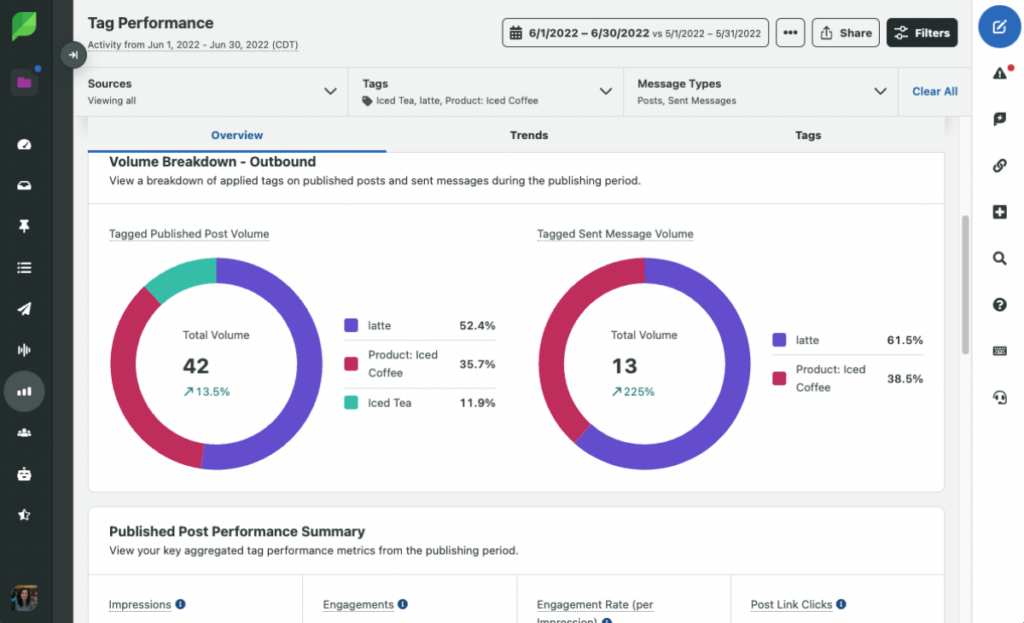
Website traffic
Social media drives significant referral traffic to e-commerce websites. When someone clicks through your social post to your website, that click is recorded as referral traffic.
If you don’t already track website traffic driven by social, this is your sign to start. According to The 2023 Sprout Social Index™, 60% of social strategists, managers and directors regularly track social media traffic to the website. And for good reason—website visits from social clearly illustrate the impact of social media on business.
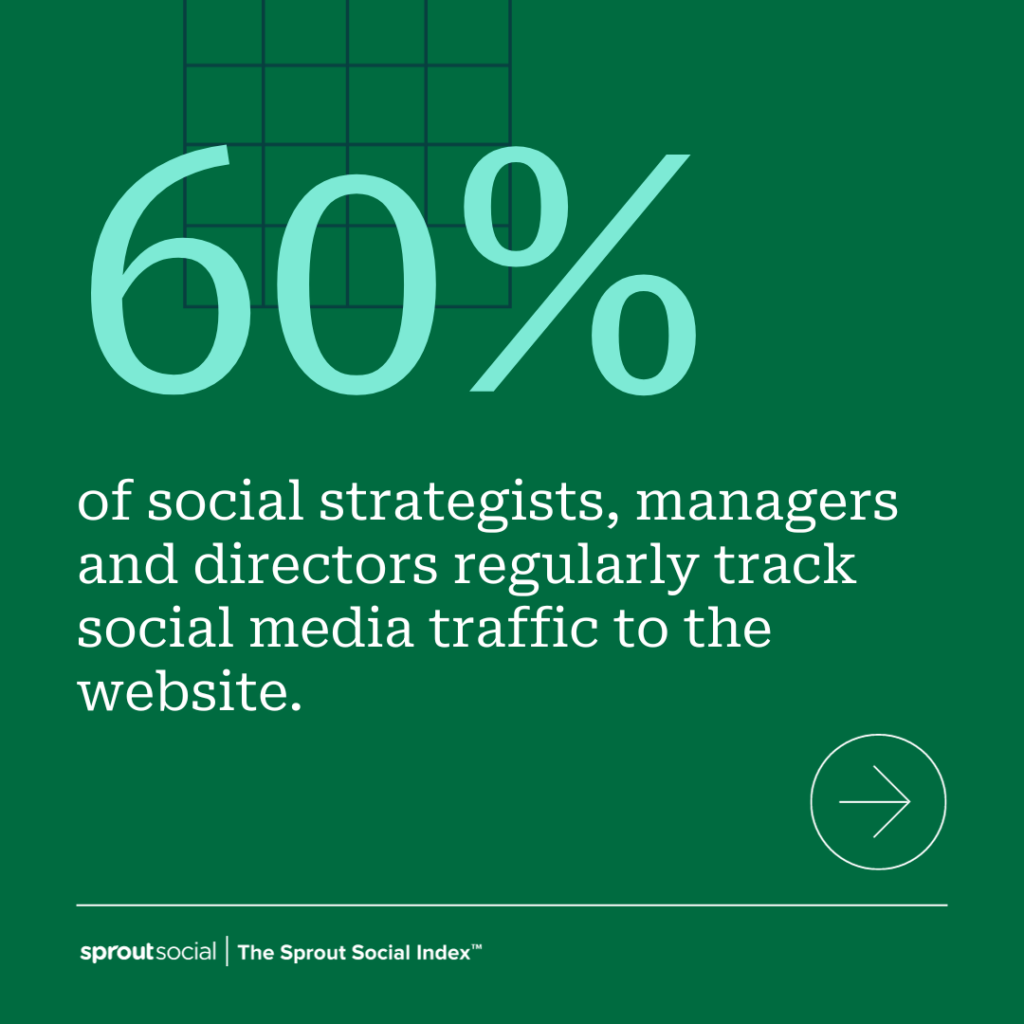
To track website traffic, connect your Google Analytics account or look at your website’s native data. Go a step further by using UTM trackers to identify which sources the clicks are coming from. This way, if your website receives a sudden influx of visitors, you’ll know which one of your Facebook posts it’s from.
Website traffic data influences are dependent on how your company operates. For example, if you make a significant amount of sales in the fourth quarter, your website traffic data will reflect this. Or, if you create a blog post that news outlets pick up, that also factors into the data.
Learn how to set up your Google Analytics account in our Google analytics and social media article.
How to find website traffic in Sprout
When you connect Sprout to Google Analytics, you’ll be able to go beyond tracking where your website clicks come from. You can also conveniently build your UTM tracking as you compose your social posts. With this tracking activated, you have a more comprehensive view of your website traffic.
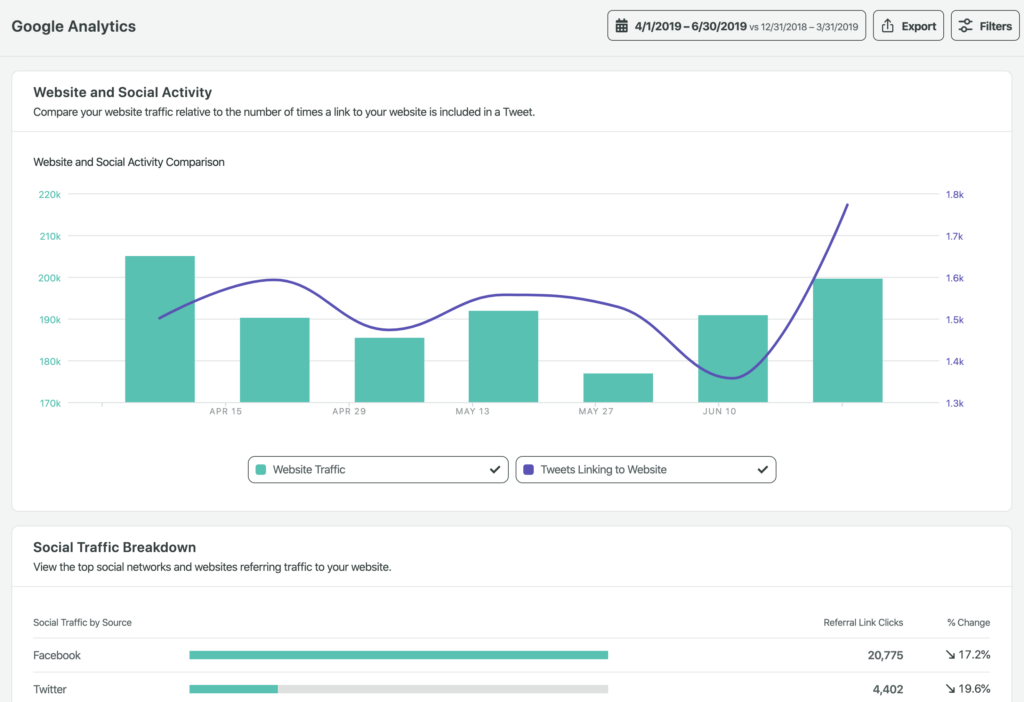
Brand awareness
Brands benefit from being present on social media. In fact, 80% of consumers say brand awareness makes them more likely to buy on social. Building brand awareness comes in various forms; a reshare of a post, a targeted video ad or reviews all count as brand awareness. Online reviews and recommendations from trusted sources are known to influence purchases, boost social proof and can double as resharable content.
This makes audience reach an important metric to track to identify your social media value.
And social teams know it. According to the Index, 58% of social strategists, managers and directors regularly track reach and impressions—core brand awareness metrics.
Follow these tips to boost your company’s brand awareness on social media.
How to use Sprout to analyze brand awareness
There are several ways to use Sprout to analyze brand awareness on social media. Sprout’s cross-channel reports enable you to assess how each of your channels and posts drive brand awareness in one report.
And with robust listening tools, you can build and track topics that are most relevant to you. You can then view data in Listening Topics to see how well your brand is performing against competitors and your share of voice in your industry.
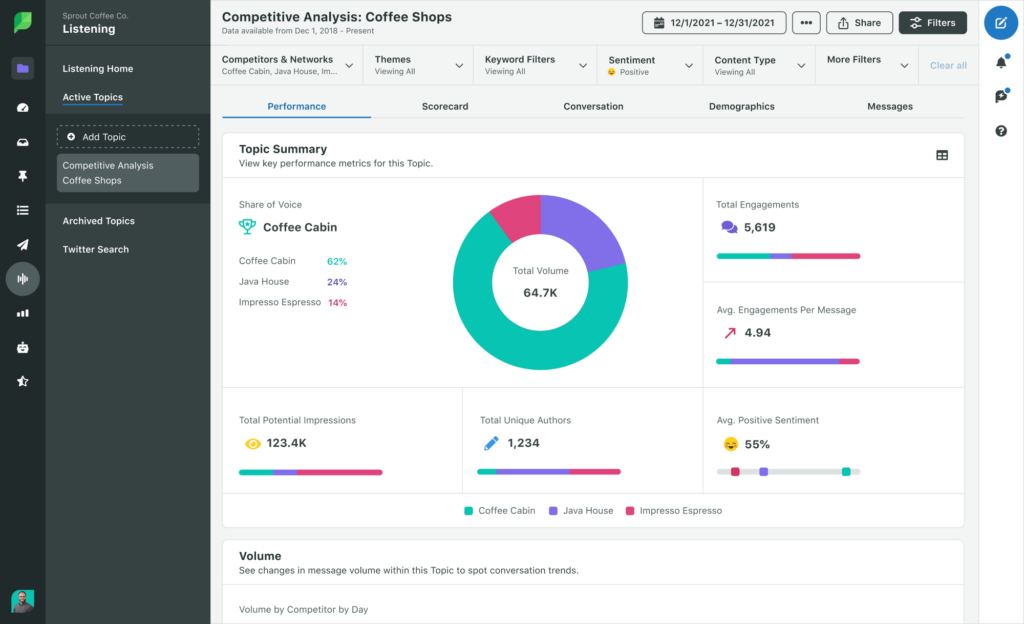
Using hashtags in your posts allows you to track their performance, too. With specific hashtag types, you can see how each one performs within your Listening Topics—especially the Twitter Trends report (which will soon rebrand to the X Trends report), which enables you to uncover popular topics and hashtags related to your brand. Knowing these will help you craft content to build brand awareness.
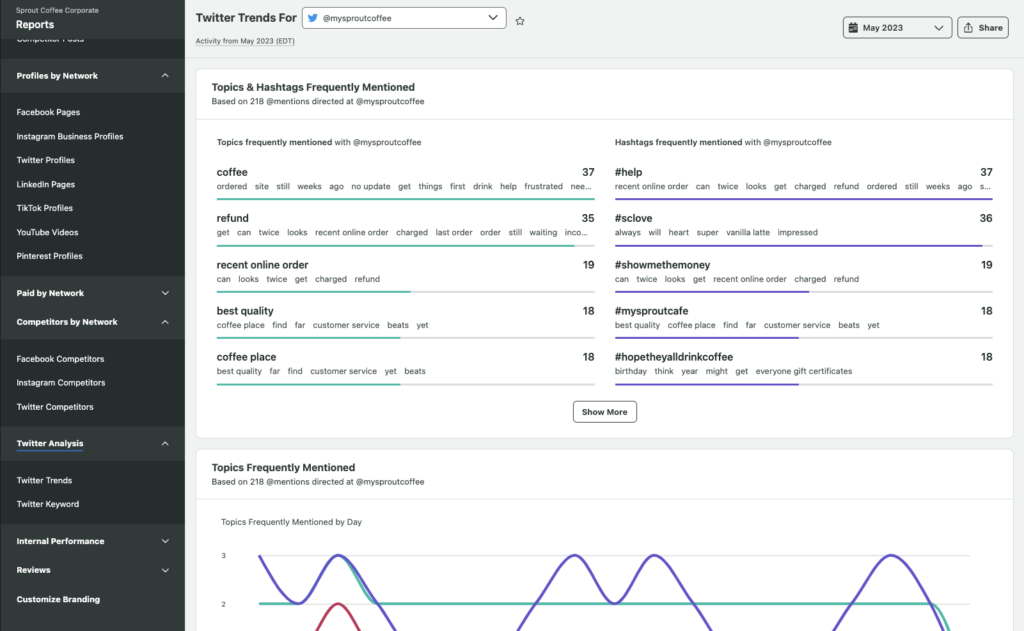
Purchases/revenue from social
Connecting sales directly to your social media efforts is a clear way to prove social media value. So much so that the Index found 57% of marketers plan on connecting the value of social to business goals in 2024 by tracking conversions and sales driven by social efforts.

There are a number of ways to measure purchases driven by or made directly on social. Here are three key ways to do this:
- Track sales with Google Analytics (and in Sprout): We already talked about how UTMs and Google Analytics enable you to track traffic from social—and how you can use them in Sprout. Take this a step further and use these tools to measure sales made from social, too. Using Google Analytics, you can track how much your social media efforts are driving sales and conversions, and which channels are most effective drivers of sales. Conversion reports and top conversion path reports give you a good idea of what channels and activities are driving sales.
- Tracking sales made through social media shopping: Social platforms have been making their shopping capabilities more user-friendly, with TikTok as the latest social platform to officially launch shopping capabilities to users. And social shopping works: 69% of retailers report selling on Facebook, and 59% report selling on Instagram. Built-in platform analytics make tracking this easy. Meta, for example, offers robust insights in their Commerce Manager to track shopping events on their social platforms and on your website (if you’ve added your Meta Pixel).

- Tracking conversions made from ads: Social media platforms—especially Facebook and Instagram—offer many creative advertising options and formats. Whether you’re using shopping ads that pull in product information directly from your site or ads promoting your brand as a whole, tracking sales made from your paid social media campaigns is essential. In Sprout, the Cross-Network Paid Performance Report simplifies tracking web conversions, cost per conversion and more driven by ads across Facebook, Instagram, LinkedIn and X (formerly known as Twitter.)
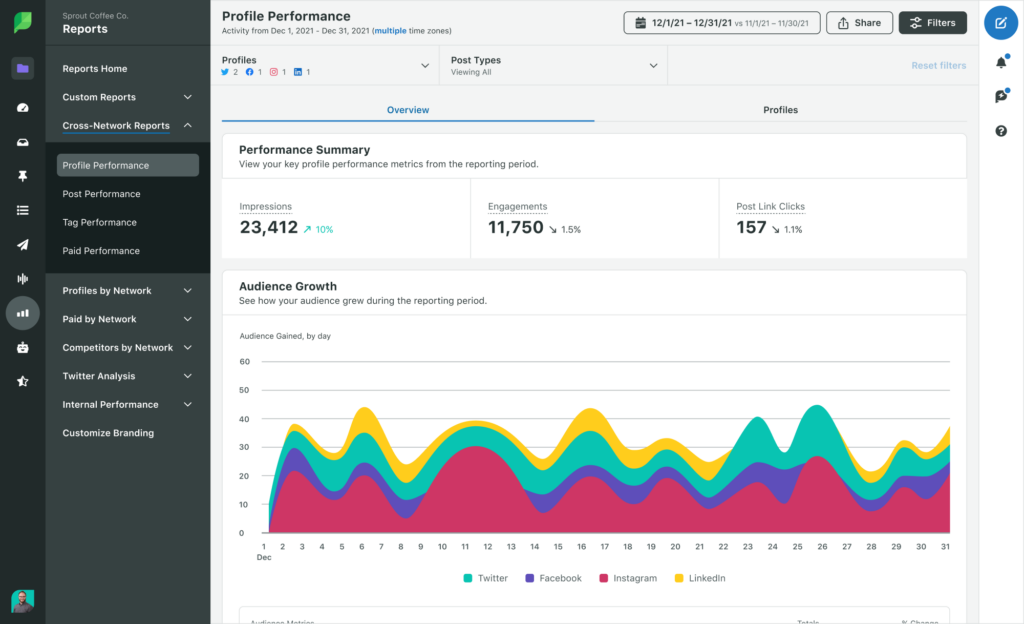
Engagement
Social media engagement includes clicks, likes, reposts, follows, views and incoming messages. It’s one of the most important social media metrics to track.
Healthy engagement involves brands publishing content their audience is interested in. In fact, according to the Index 45% of consumers say their main reason for following a brand is because they post enjoyable, entertaining content. Tracking engagement ensures you’re monitoring the value of your social media content.

But engagement also involves the brand engaging with customers who interact with their posts. And a little goes a long way.
Need ideas on creating great organic content? Check out these four types of content for driving engagement. Or, use these proven social media optimization strategies to boost social engagement.
How to track engagement in Sprout
Engagement is available as a metric in multiple reports at the profile level, network level and post level. The number is further broken down into the types of engagement, like clicks and comments.
Customer satisfaction
Traditionally, this is a customer service team metric. But social customer care often falls under the marketing umbrella. And given that 76% of consumers notice and appreciate when companies prioritize customer support, measuring their satisfaction is a core piece of social media value.
There are a number of ways you can measure this, including with the most on-the-nose metric—your customer satisfaction score (CSAT). However, this metric requires sending a survey, often via email or customer service chatbots. And while it tells you the overall CSAT rating, it’s not always clear why the customer chose that rating.
So here are a few additional customer service metrics to watch:
- Average first reply time
- Average reply wait time
- Reply or response rate
- Sentiment
- Most received topics
How to measure customer satisfaction in Sprout
Sprout has several ways to measure customer satisfaction. The Inbox Team and Activity reports, which we’ll get into later, shed light on how responsive you are to your customers. But Sprout also offers customer feedback surveys that measure your social CSAT or Net Promoter Score (NPS). This survey can be implemented in your Instagram, Facebook and X private messages to get the pulse of how happy customers are with your help.
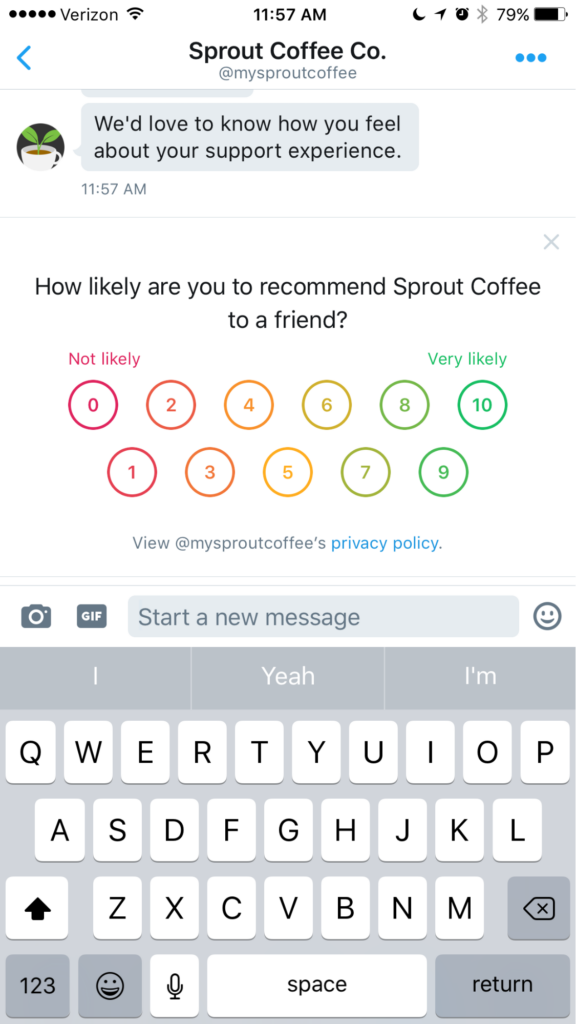
Sprout’s Social Listening solution also empowers you to go straight to the source and to understand how customers feel about you, your competitors and your products or services. This is a great tool to use to uncover what improvements must be made to boost customer satisfaction.
Lead generation
Wanting to reach customers in the consideration stage of their purchase journey is a common social media goal. According to The Sprout Social Index™, 44% of marketing VPs and executives regularly track conversion rates and leads generated on social media.
To set up analytics for your lead gen efforts, create unique tracking links (the UTMs we talked about) that track when customers take an action on a link. This makes it easy to track what platforms, posts, ads and promos drive the most consideration-stage interest.
Tracking links also make it possible to identify return visitor activity and people who continue to interact with your website after visiting social. This will show you how well your social activity—and specific channels—are warming up leads. If your social management tool has integrations, you can even take this one step further by tracking specific leads in a CRM platform, like Salesforce.
If you’re stuck on how to grow your brand on social, here are some ideas for lead-gen campaigns.
How to improve lead gen with Sprout
For lead generation efforts, Sprout connects with Shopify and Facebook Shops to tag your product offerings. When a customer inquires about a product, you can easily add a direct link to the reply.
You can also seamlessly communicate with your sales team when you find a lead on social. Tag your sales team on incoming messages from potential leads to help move them down the funnel.
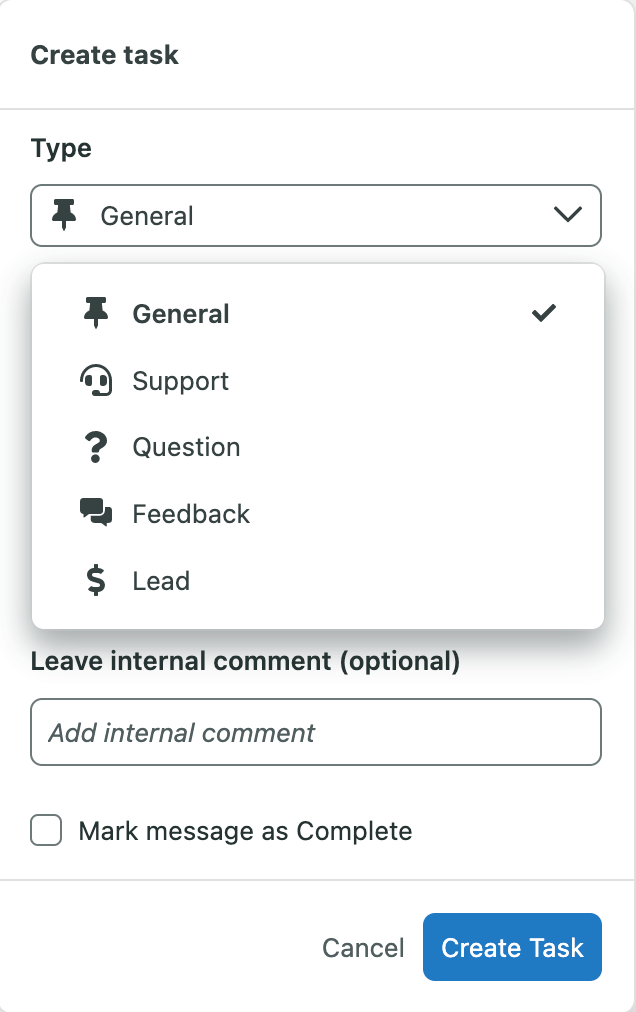
Finally, tracking leads is even easier and more granular when you use Sprout’s Salesforce integration. This empowers you to seamlessly connect your CRM with social data, so you can surface insights alongside your other marketing metrics and spark lifelong customer relationships.
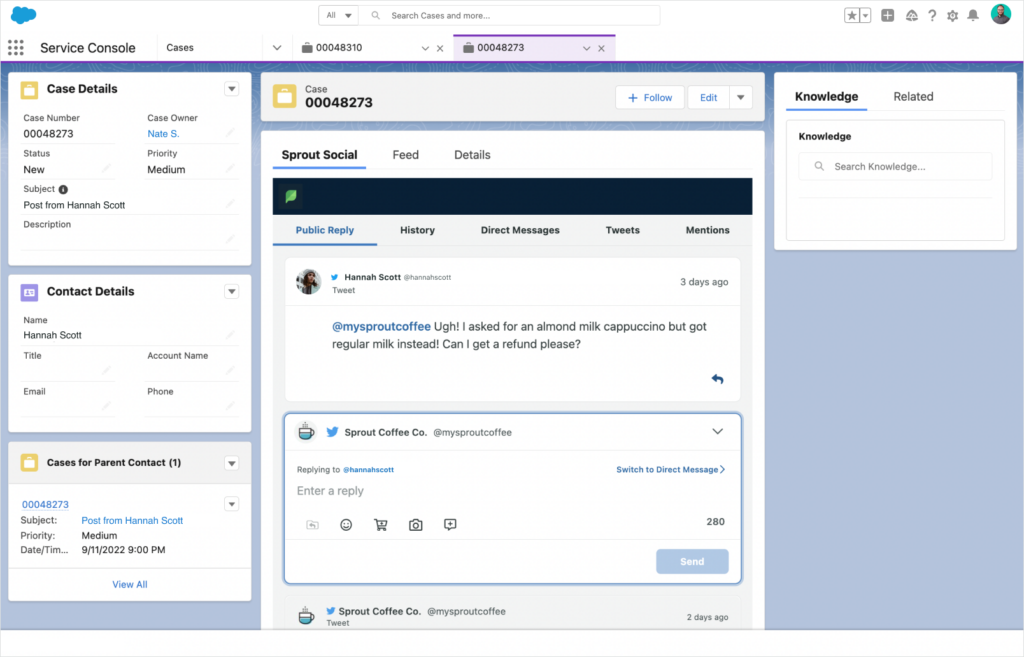
Customer retention
It’s great to attract new customers, but don’t forget about your current ones. It’s also cheaper to retain current customers than it is to score new ones. It can cost up to seven times more to acquire a new customer than to retain an old one. Existing customers are also 50% more likely to try new products and spend 31% more than new ones.
Measuring customer acquisition costs is a metric marketers have their eye on. The Index found 29% of marketers plan to connect the value of social to business goals in 2024 by calculating this metric.
Create useful content and offer after-purchase customer service support to increase retention rates. Employ customer retention strategies like rewards programs and feedback emails.
And simply be responsive on social. It can encourage customers to feel connected to your brand. According to the Index, 51% of consumers say when brands simply respond to customers, it makes them memorable.
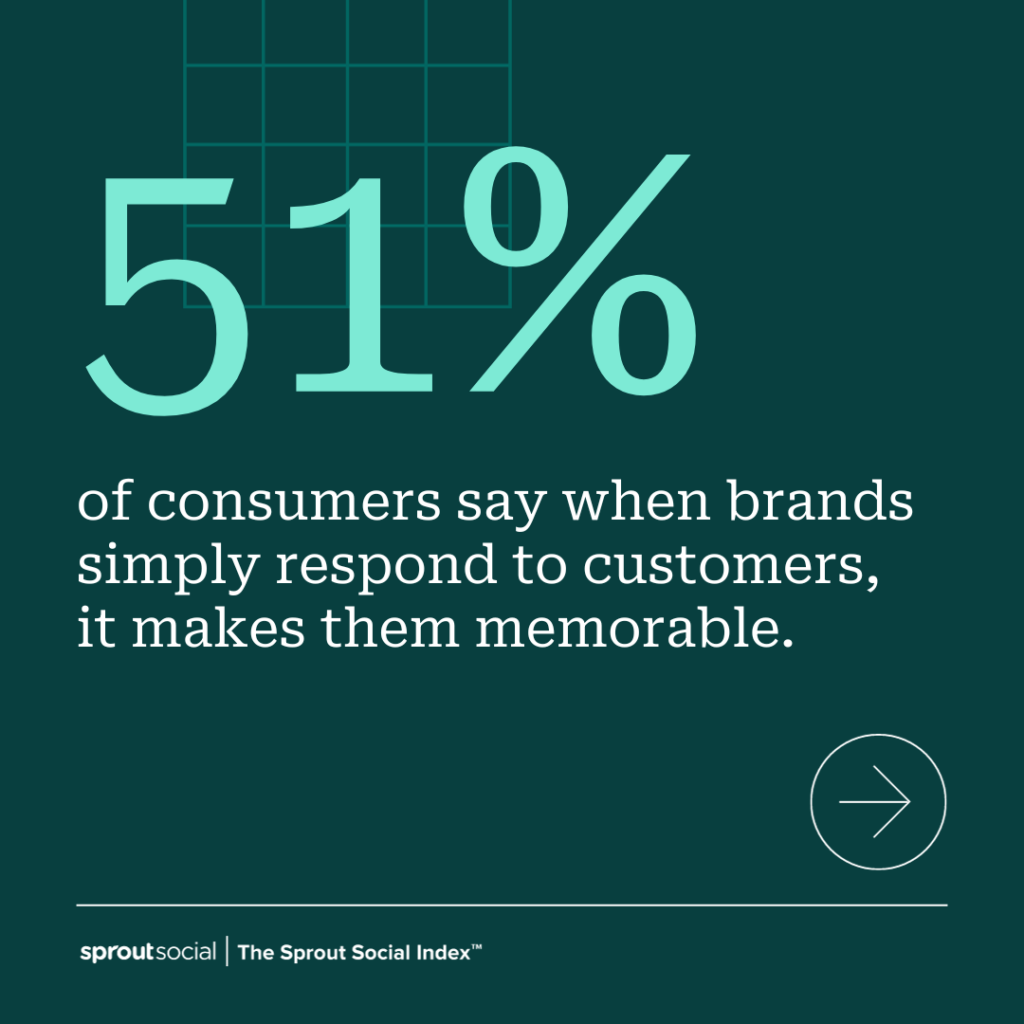
How to improve customer retention in Sprout
Sprout’s Smart Inbox is designed to support customer retention. With filters and custom views, never miss a social media message again. The reporting features include useful metrics like response time, unique messages and action rate. Don’t assume your team is replying; gather the data that proves it.
Start your free Sprout trial
How to communicate the value of social media beyond the marketing department
The insights you glean from social have the potential to inform and help every team at your org meet their business goals. Today, 76% of social marketers say their team’s insights inform other departments, according to The 2023 Sprout Social Index™. And yet, 43% of social teams still feel siloed.
You and your team already know that other teams can benefit from social insights. But those other teams may not understand the value of social media for their goals. Here are a few examples of how you can communicate the value of social with other teams beyond marketing.
Before you start: talk to team leaders to understand their needs
Not every metric or finding will be important to every team. Take time to talk to leaders from each team. What are their goals? What are their pain points? What do they need to be successful, and what does their team care about?
Asking questions early on will help you understand which social insights matter most to each team. Then, you can create tailored reports that highlight exactly what they need to know.
This is also where you can understand how often to share reports with other teams and stakeholders. The majority of social media marketers share social performance reports with executive leadership weekly or daily, according to the Index. And tapping into automation will help you set and forget your reports or scorecards you create.
Sprout, for example, enables you to build custom reports tailored to different teams, and enables you to set a regular sharing cadence.
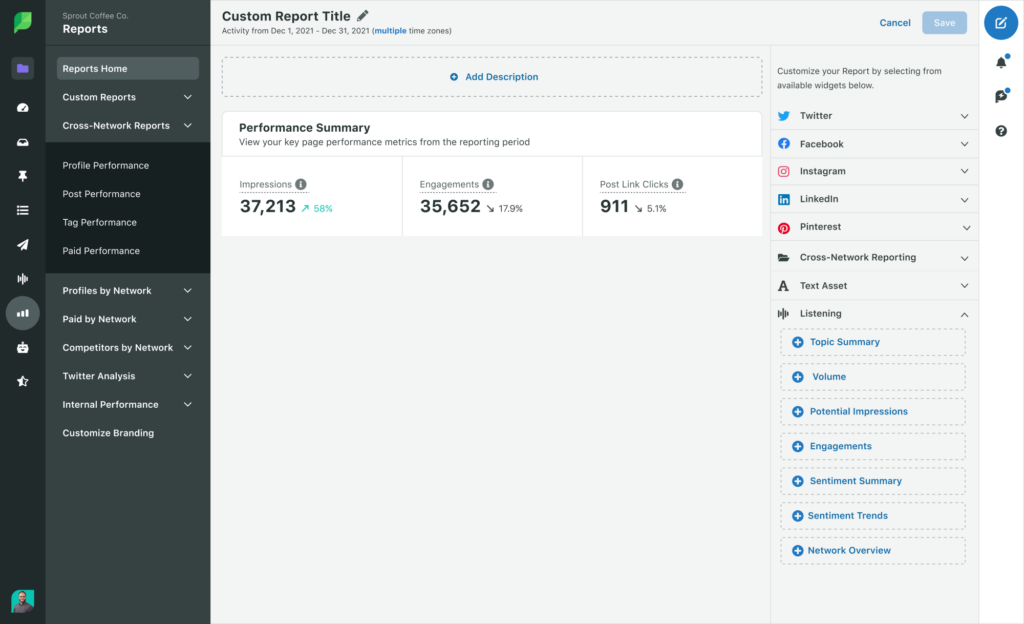
Uncover customer care performance and opportunities
The Sprout Social Index™ found most marketing teams either split social customer care with the customer service team, or they own it. But regardless of how you divide up responding to customers on social, if your customer service team isn’t tapped into social, they may be missing key opportunities.
For instance, incoming social FAQs can help customer service understand where customers most often need help. This can inspire them to create new FAQ resources, customer self-service tools, chatbot answers and more.
Social media insights are also key for your customer service team to understand their performance, what they do well and what needs improvement. After all, 69% of consumers say they expect a response from a brand within a day. And metrics like your average first reply time or reply rate can uncover how quickly your team responds to messages, and how long customers are left waiting.
Using a tool like Sprout’s Inbox Team and Activity reports quantify how quickly customer care agents respond to customers and their response rate. This clearly illustrates whether their responsiveness meets customer expectations—or even exceeds them.
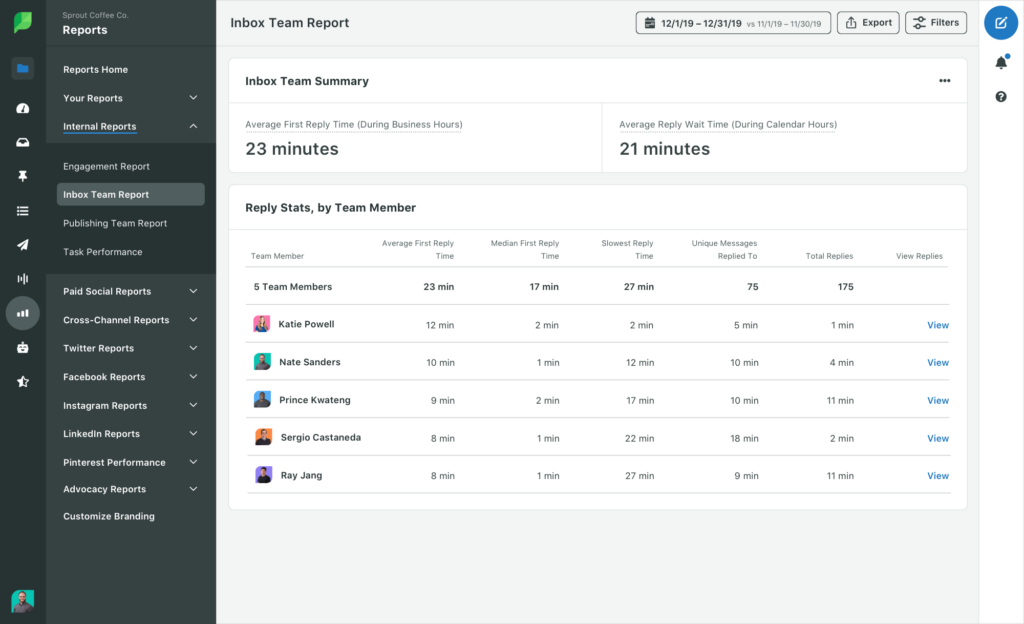
Predict market shifts for your product team
In our fast-paced world, being proactive vs. reactive is essential. And social media is the best source to identify trends…if you know how to tap into the conversation.
Social listening is an often untapped tool that product teams can greatly benefit from. By tapping into the wider conversation on social, beyond just your channels, social listening empowers you to identify trends and market shifts proactively.
Clothing brand River Island is a shining example of a marketing team that changes the game for its product team with social insights. They used social listening to discover that fringe jackets were coming back as a big trend. This is social data in action—while these insights are invaluable to the product team to stay ahead of trends, they also inform the social team what they should push on social.
Social listening also puts a microphone up to what your ideal customers are saying about your products and competitors’ products. Sprout’s Competitive Analysis Listening Tool empowers you to uncover these conversations, helping you unearth customer pain points that need fixed, and opportunities to differentiate your brand and products from the competition.
Create a reference for your creative team on visuals that resonate
It’s no surprise that 79% of social strategists, managers and directors regularly check engagement metrics. But these metrics are helpful for teams beyond social, like your creative teams.
When I managed social media for a non-profit, the visual team asked me if they could see how their photos and videos performed once posted. Not only would engagement metrics give them insight into what was performing well—it was also a good indicator of what types of visuals our audience reacted to.
If you work with a team that provides you with graphics, photos, or videos, share engagement with them to help them understand what resonates with your social audience.
Pulse check audience sentiment for your PR team
Hopefully, you and your PR teams never experience a social media crisis—big or small. But if you do, it’s always better to catch it early where you can still get ahead of the narrative.
Social media is where that chatter starts and takes off. But it’s not always on your channels first. To understand how your brand is being talked about and perceived, you need to zoom out.
Using social listening is one of the best ways to catch a potential issue bubbling up early. It empowers you to identify keywords people are using while talking about your brand, sentiment dips and more—which is invaluable information for your PR team.
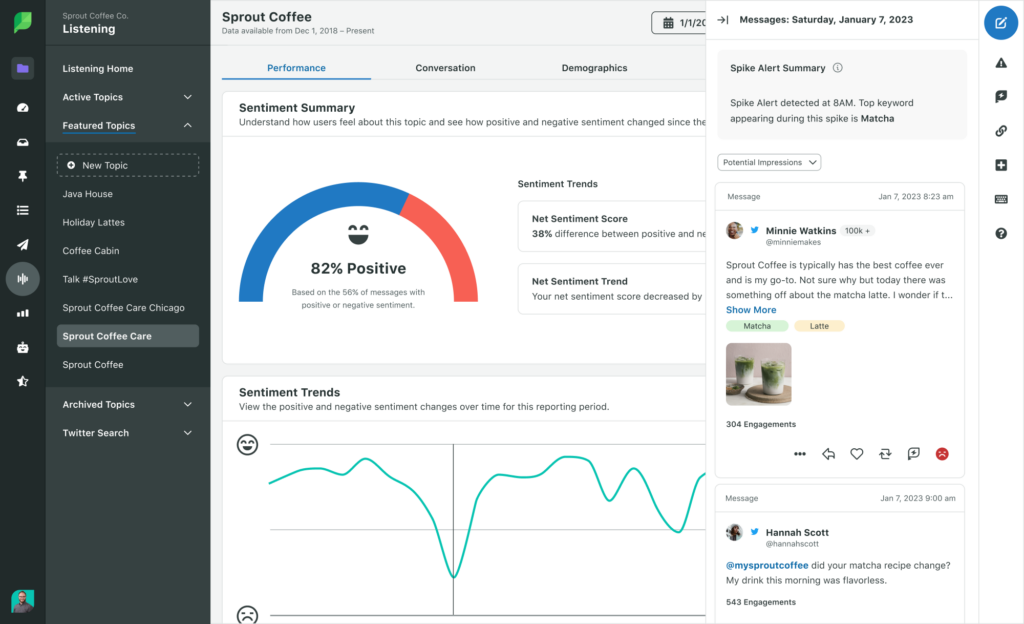
Collaborating with your PR team can also help you create a social media crisis plan that involves social listening to keep tabs on the conversation.
Show your entire organization the value of social media marketing, and how it can help them
Social media offers a wide range of value for brands and businesses alike. But while the value of social media to business goals as a whole is clear, it’s up to you to show other teams what social can do for them.
By honing the right metrics, creating tailored reports for each team and understanding what social insights matter to each team, you can help grow your whole org—one department at a time.
Making social data more accessible and useful cross-org will only become more important. If you’re looking for data to help make the case that every team needs social insights, download and read our latest Sprout Social Index™ report.

